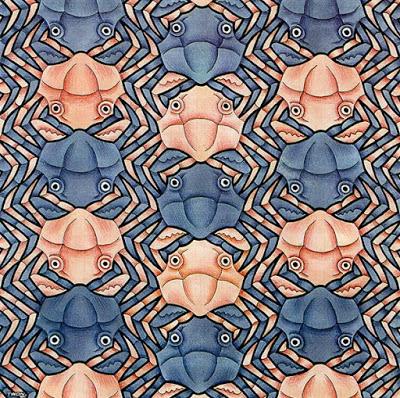by Jivana Heyman
Crab Cannon by M.C. Escher
This research made me reflect on the human condition and our tendency to recreate unresolved issues in our personal lives––don’t we end up marrying someone just like one of our parents or literally becoming our parents as we age? It also reminds me of the tendency for civilizations to repeat history. Any student of history can’t help but see the parallels between the current U.S. government and the pre-World War II Nazi government.
It seems like an unavoidable aspect of human nature that we are destined to repeat our past mistakes. I wonder if there’s something similar happening in the yoga world? I sure hope not. The history of yoga in the West provides too many examples of yoga empires built on manipulation and abuse. The most recent examples are Bikram, Ashtanga, Sivananda Vedanta, and Kundalini, which have all had major abuse scandals in the last few years.
Are we destined to repeat this history or can we find another way forward post-covid where we engage with our practice effectively enough to see through our samskaras (the mind’s tendencies)? Last week, the biggest yoga chain in the world,YogaWorks, declared bankruptcy. “The COVID-19 pandemic has created unprecedented challenges for our industry and business, including mandatory studio closures and social distancing-imposed attendance restrictions even where studios have been permitted to reopen,” said Brian Cooper, Chief Executive Officer of YogaWorks. Honestly, that’s the least of the damage that’s happened through the pandemic. What about the fact that almost all independent yoga studios are permanently closed and most yoga teachers are out of work?
The question is: Can the demise of the modern yoga studio offer an opportunity to build something new in its place, or are we destined to recreate the same issues that plagued the industry before the pandemic? Those issues include a lack of accessibility, racism, abuse, and unaddressed cultural appropriation. These issues all stem from a system based on greed and profiteering, rather than a system built on the foundational yoga teachings.
In other words, the yoga industry became a hollow shell, serving up a form of practice divorced from the philosophical and moral foundations of the very thing it was purportedly selling. The yoga industry became a crab; it evolved into that same form that our greed and selfishness often recreate, a system built on profit and bottom lines.
The thing is, the yoga teachings are completely at odds with capitalism. You literally can’t sell yoga. You can sell the fancy accoutrements that go alongside it and you can sell a body type that really has nothing to do with it, but you can’t sell yoga. You can sell time in a room with a teacher, books, and online courses, but the yoga is free.
So how do we build back better? How do we create a yoga community rather than a yoga industry based on profit? To be honest, we probably can’t. We’re just going to build another crab. But, there might be a group of us that breaks off and has a chance to evolve into something else—maybe a jellyfish or an octopus? I imagine that commercial yoga will come roaring back at some point. I don’t think we can stop that evolution, but we don’t have to contribute to it.
We can create a different kind of yoga community built on yoga’s foundational ethics: ahimsa and satya, nonviolence (compassion) and truthfulness (honesty). This means we need to acknowledge the harm that has been done in the name of yoga and commit to change. It’s not about shame, but clarity (viveka).
I’m not suggesting we create a new organization, new teacher training standards, or a new yoga style. Instead, I am simply asking you how you can become more dedicated to the truth of yoga in your life? (And I’m asking myself these same questions.) Is there a way to dedicate ourselves to the truth of yoga, rather than to the lie of yoga marketing? If so, it starts with self-inquiry, asking ourselves questions like this:
- What does yoga mean to me?
- Does my practice, and teaching, reflect that truth?
- Am I integrating ahimsa (compassion) and satya (honesty) into my practice?
- Are my practice and teaching accessible, actively anti-racist, and addressing cultural appropriation?
- Am I dedicated to my own freedom and the empowerment of my students?
- What is the relationship between my personal liberation and communal liberation?
All yoga practitioners need to consider the way they are practicing and teaching, and the impact they are having on the world around them. This intimately personal exploration allows us to come together in our hearts and to create a yoga community based in yoga with its moral foundations. Otherwise, we just end up evolving into crabs.

This post was originally appeared on the Accessible Yoga blog, where it was edited by Patrice Priya Wagner, Managing Editor of Accessible Yoga blog and member of the Board of Directors.Subscribe to Yoga for Healthy Aging by Email ° Follow Yoga for Healthy Aging on Facebook ° To order Yoga for Healthy Aging: A Guide to Lifelong Well-Being, go to Amazon, Shambhala, Indie Bound or your local bookstore.


